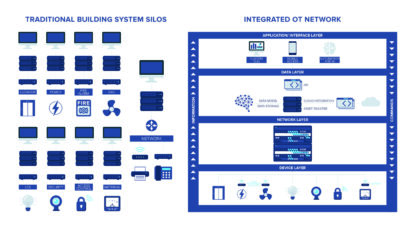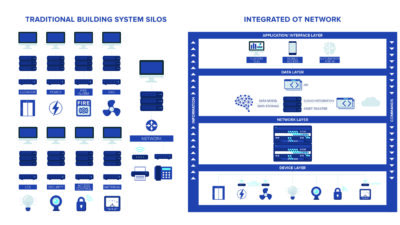Office building clients demand sustainability, flexibility, and cost conservation in both new and existing buildings.
Respondents
Michael F. Cooper, PE, LEED AP, Managing Principal, Harley Ellis Devereaux, Southfield, Mich.
Kurt Karnatz, PE, CEM, LEED AP, HBDP, HFDP, President, Environmental Systems Design Inc., Chicago
Kent W. Peterson, PE, FASHRAE, LEED AP BD+C, BEAP, Vice President/Chief Engineer, P2S Engineering Inc., Long Beach, Calif.
CSE: What factors do you need to take into account when designing building automation systems (BAS) for an office building?
Karnatz: First cost is the primary factor lately, but in our budgeting conversations with owners we try hard to keep total cost of ownership at the forefront too. We stress the lifecycle cost advantage of standards-based open protocols, open software licenses, and hardware lines free from exclusive territory-based distribution restrictions. We strive to provide instrumentation and controls sufficient to operate each system efficiently and reliably, and encourage owners to include additional sensors for equipment performance and energy monitoring.
Peterson: We need to determine whether the owner works with a sole-source manufacturer or prefers an open protocol system. We also discuss user interface issues with the owner to understand what capabilities are important to the operating personnel.
Cooper: The key factor is alignment with the owner’s operations and maintenance (O&M) program for the building. The BAS is meant to improve the ability to manage the building and support systems—to better predict maintenance needs and costs, so that resources are better used and costs are kept in line with budgets. When a BAS is too sophisticated, we get the opposite result. The system becomes a burden for the owner and an obstacle for effective building management.
CSE: How does implementing BAS in an existing building differ from designing controls for a new building?
Peterson: Implementing BAS in an existing building will require evaluating the existing control devices to understand what can be reused and integrated into the new BAS. This can save an owner on the cost of implementing BAS in existing buildings.
Cooper: In a new building, we deal primarily with digital controls where systems integration can be readily accomplished without too much difficulty. In existing buildings, we often address systems without comprehensive controls or with control systems that don’t easily integrate with a new BAS. It’s important to evaluate when replacing the existing control system is appropriate versus integrating the existing system. Wireless control systems are also a viable consideration for existing buildings, where installation of new systems cannot be easily accomplished.
Karnatz: In existing buildings, you rarely have the budget required for a complete rip and replace, so incorporating or working around legacy pieces and systems is the big challenge. Solutions often require incorporating a degree of pneumatics, software integration to legacy direct digital control (DCC) systems. We try to find economical solutions for network architecture using existing pathways. In new construction, it’s a blank slate, so engineering a solution is generally much more straightforward.
CSE: What types of energy management systems are you specifying on office building projects? Are these part of full-building control systems?
Karnatz: In office building projects, we incorporate energy monitoring and management into the overall building BAS. Done properly, energy management is baked right into every air-handling unit (AHU) sequence of operation and every lighting control strategy. Energy meters provide required information to any energy management function but also yield rich insight into basic equipment function. Implementing energy management as an overlay on top of specialty subsystems is certainly possible but can get quite complex.
Cooper: The majority of energy management systems we see today are comprehensive monitoring and control systems that are part of full-building solutions. The monitoring component of these systems enables owners to track energy consumption in real time, make that data available to financial personnel to inform corporate budgets, and also make adjustments when consumption exceeds predicted demand. The control component of the systems enables building management staff to effectively manage the building, often when building management resources are shrinking.
Peterson: All our projects in the past 15 years have implemented full-building energy management and control systems.
CSE: What new types of controls are you specifying into office buildings? Is the demand for personal control increasing?
Cooper: The demand for personal control is increasing, and building system technology makes this possible in many environments. Web-based controls are helping building owners provide more personal control as well as better manage all of the harvested data. Building occupants can view current environmental conditions of their space and the status of building systems. Building management personnel can likewise view this information from anywhere they happen to be. With a smartphone, laptop, or tablet, they can immediately respond to issues, troubleshoot systems, and make adjustments to system operation as necessary.
Peterson: Building control systems today include controls from the zones to the major equipment. They implement demand-based control strategies that reset equipment requirements based on actual zone requirements. We are also seeing better integration of smart lighting controls into the BAS. We have not seen much demand from building owners for personal control below zone control.
Karnatz: Personal control at the room level (i.e., private office, conference room) is fundamental to good lighting controls design. We haven’t seen any demand for PC-based personal control in commercial (for lease) offices. The management required to deal with tenant moves and changes is daunting to a base building. In owner-occupied spaces, we have seen some interest, but there is still fear about change management—who will be responsible, the facilities team, or the IT team? Phone-based personal control has promise, but to date we have only implemented this solution for one client, and it was the phone-based software that they themselves authored, so we were just helping them to practice what they preach. We are beginning to recommend advanced applications such as fault diagnostics and energy analytics on our consulting engagements, but it remains challenging to incorporate these applications into bid specifications on a standard design project. The complexity and customization required of these systems lend themselves better to owner-negotiated purchases.



